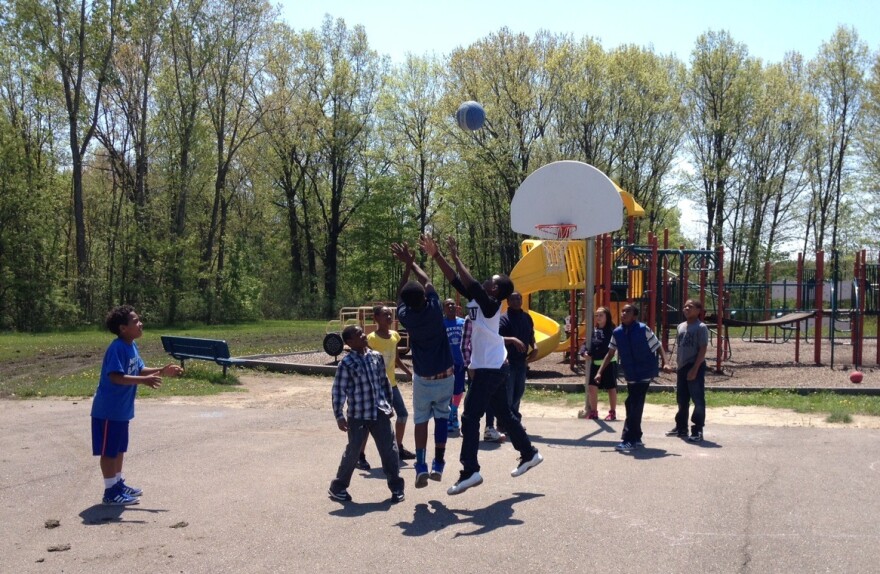Last fall, I spent a ton of time in two different fifth-grade classrooms: one made up of poor kids, the other made up of kids whose families are mostly well-off. I wanted to see how the two classroom experiences differed, and boy did they ever. We're talking night-and-day differences here.
Don't believe me? Take a listen for yourself.
I decided to revisit the poor school to see what – if anything – had changed.
At the beginning of the school year, the students at Myers Elementary in Taylor struggled with math, reading and discipline issues. Here's what the classroom sounded like back in September:
And here's what the classroom sounded like when I returned to the school in May:
Pretty similar, right? Believe it or not, there are actually fewer kids in Kathie Bower's fifth-grade class now than there were at the beginning of the year. Bower's class list in the fall had 40 kids on it. That's right. Forty fifth-grade students in one small classroom without air conditioning.

She’s now down to 30 kids … at least, she thinks so. "I’ve gained and lost so many kids since you were here," says Bower, so it's hard to keep track of how many she has.
All of the kids in Bower’s class are what you’d call “at-risk.” They all live in poverty, their test scores are well below the state average, and most live in single-family households with parents who never went to college.
In a lot of low-income communities like this one, school is more than just "school." Parents are just trying to make it day to day, so it falls on principals and teachers like Bower to fill in the gaps, to ask the students: Do you need a backpack? Did you get enough to eat this morning? Do you need a ride to school?
And then there’s the transiency problem. Kids are in and out of school for weeks at a time. So even nine months into the school year, Kathie Bower still has to spend a huge chunk of her day reminding students how to behave.
"I think we wasted a lot of time on discipline," explains Bower, and "that hurts my heart. But I believe that there were some really amazing learning things that happened this year."
For example: Every single person went up in their reading level. They also learned a lot of new math facts, like how to multiply and divide fractions and how to do long division.
One student got a lesson of the heart:
And at least one student, a young boy named Montez, has come away with a new outlook on his future. When I first interviewed him back in the fall, he very bluntly told me he didn’t plan to go to college.
I cornered Montez when I went back to Myers and asked him if he had changed his mind about college. His answer surprised me. He said yeah, he wants to go to college now. His reason? "I don't want to be no bum."
He has his principal, Diedre Zockheem, to thank for his new outlook on life. "I literally sat down and talked to him and said, 'Montez, your ticket out of poverty is college. You have to go.'"
Zockheem says Montez was never introduced to the concept of college. I believe it. There was a clear difference between Myers and Novi, the two schools I followed for much of last fall. Here's what I wrote back in October:
While they work on their math arrays, I walk around and ask them: Why do you think you’re learning all this stuff in math? "Because we might need it later on in like 7th grade or something" "So we can know it in a higher grade and be smarter" "So we can learn, do better in high school" "For the MEAP to get ready for." Only one student told me ‘so they could go on to college and get a job.’ Now contrast that with the type of answers I got in Novi, like this one: "When we’re older and jobs, lots of jobs require math, so if we don’t learn the basics when we’re younger and like build up on what we learned, then we’re going to be really confused." College, jobs, careers. When the Novi kids answered my ‘why are you learning all this stuff’ question, they focused on the far future. Which makes sense. Being able to think about the future is a luxury – a middle class and upper middle class luxury. For kids in poverty, their concerns are much more immediate. Will there be food on the table for dinner when I get home? Can my Mom afford to buy me a new winter jacket? There also just doesn’t seem to be an emphasis at School X [Myers Elementary] on the future. Between the constant discipline and the prep for the MEAP, there’s just no time.
So kids like Montez lose out – unless they have a person like Zockheem watching their back. Luckily for the kids at Myers Elementary, Zockheem has no plans to leave the school anytime soon. She’ll be there to help the next set of fifth-grade students. To show them how education – if they stick with it – can also be their ticket out of poverty.
To hear the original hour-long show comparing Myers Elementary and Novi Middle School, check out our State of Opportunity documentary The Education Gap.




